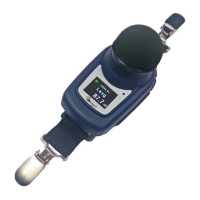May 2015 Page 45 of 51
Therefore, 35 litres divided by 8 hours equals 4.375 litres per hour. This would be the
analogous to the TWA(8h) value.
Using the same values the projected dose can also be calculated. 25 litres of water has
been collected after 5 hours. If the working shift was 5 hours this would be a dose of 25/80
litres which equals 31.25% dose (this is what the dose at the end of the measurement would
be). However, as the working shift carries on for another 2 hours then a total of 35 litres
would have been run. This means the projected dose is 35/80 litres which equals 43.75%.
18. Examples of Possible Measurement Scenarios
In order to simplify these discussions, the equivalent continuous sound level (i.e. Leq or
Lavg) is used.
Scenario 1: Criterion duration (Tc) = 8 hours; measurement duration (Tm) = 5 hours;
shift duration (Ts) = 8 hours
The noise which the worker is exposed to is measured for 5 hours. However, the worker is
exposed to the same noise levels for the remainder of the shift (such that the worker is
exposed to this noise level for the entire 8 hours).
Figure 6 shows the 5 hour measurement
Figure 7 shows the 5 hour measurement (blue line); but also the same noise level continued for the rest
of the 8 hour shift (red line)
In this situation, the measured level is projected forward using the assumption that the noise
level is the same as that measured during the 5 hour measurement.
This means that the Lavg measured over the hours would have the same value after 8
hours. This results in a projected TWA(8h) being equal to the measured Lavg (i.e. Proj
TWA(8h) = 88.0 dB).

